Putter fitting with Martin Stecher
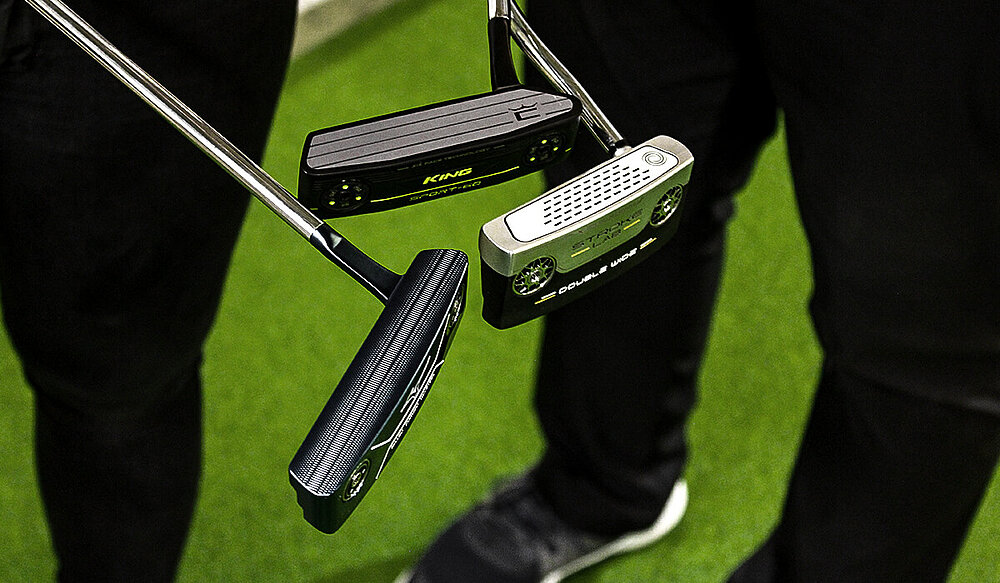
Getting your clubs fitted, is an integral part of the game for a lot of golfers. There are too many options available, too many individual and physical components that play a role in the decision-making process of buying new clubs. After all, who would like to take the risk of losing shots due to the material, right? While club fitting, in general, is very well received by most golfers, they stop short of the most important club in their bag – their putter. But why? We have visited Martin Stecher, one of Germany’s most well-known fitters, and asked him about putter fitting in general, how often you should change your putter and why he decided to incorporate PuttView in his fitting process.
After 15 years of playing golf, including college golf, four years as a golf journalist, and countless rounds of golf all over the world, I must admit, I never had a putter fitting in my life. In fact, my current putter, a trusted Scottie Cameron, is so old, I can only roughly remember when I bought it about ten years ago. In a golf store somewhere in Mobile, Alabama, USA. And even though I have been struggling with my putting at times, I never thought about it as my putter’s fault. I blamed it on lack of practice, bad greens, and all the other excuses you generally come up with when talking about putting. Just like most golfers would do and are still doing. Considering the fact, that almost half of the shots we take during a round are accounted for by putting, it is borderline crazy to think about the fact that putter fitting plays such a minor role in most golfers’ life, including mine.
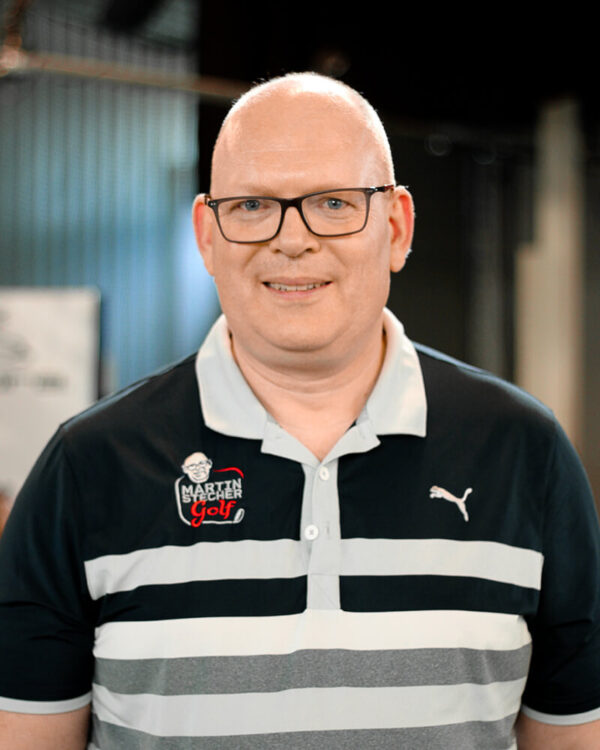
Doing things differently!
While sitting across from Martin Stecher in his studio in Nienburg, Germany, I glance at the beloved putter that is sitting on top of a box next to me. “Hand me your putter”, says Martin Stecher and stretches out his hand. At the sight of my worn-out grip, he can’t help but break out a big grin. “You really like your putter, don’t you?”, he says while inspecting the rest of it. The man in front of me is not your typical golf guy. In fact, it took Stecher 38 years before he discovered golf and his love for the game for himself. After school, Stecher joined the Federal Armed Forces, climbing up all the way to the rank Major, before studying mechanical engineering at the University of Hamburg. Even though he never finished with a degree in that subject, he proceeded and got a degree in computer science continuing his career as an IT professional.
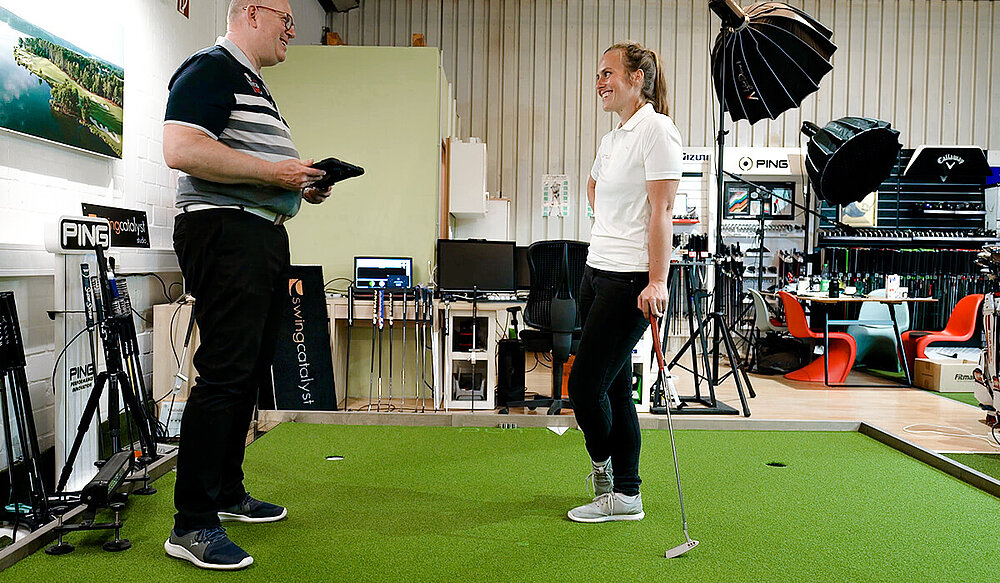
“Coaching has been part of my job for decades now”, says Stecher before continuing to ask me questions about my approach to putting. “In putter fittings, a lot of times people focus on the putter. Launch angle, loft, etc. I like to do it differently and start from the hole to the ball back to the player. The easiest way to convince someone of a putter is if they hole more putts. I make that possible. I know, the golf industry is trying to tell people to maximize the MOI or that you need toe-hang, but there is no correlation between that and you holing more putts. There’s just not.”
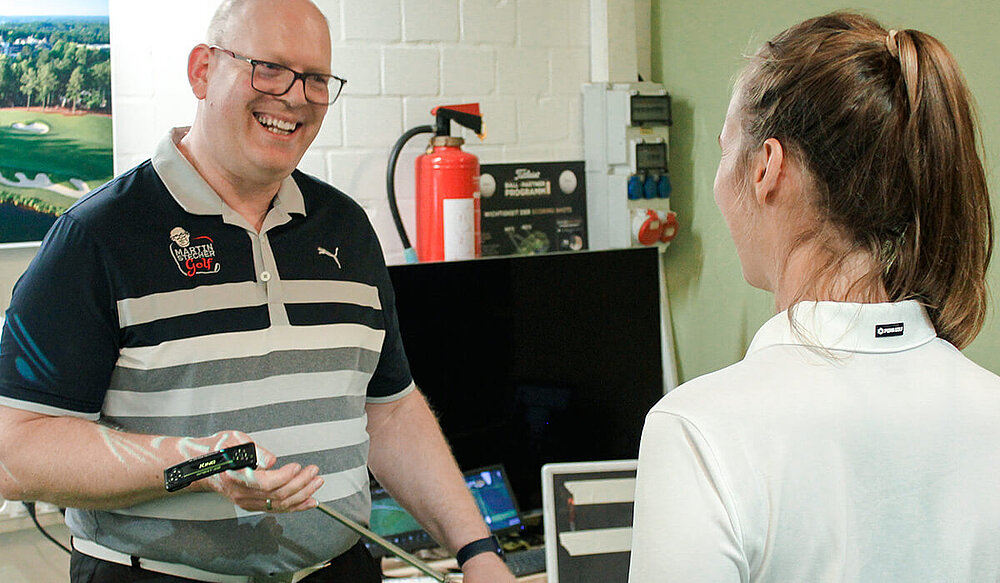
In no other part of the golf game, people change up their swings, grips, and approaches as much as they do with putting. Think about the armlock method, the claw grip, reverse putting … there are countless ways to try and get the ball into the hole. Martin Stecher has already told me, that he does not recommend anyone to get a lesson right before coming to him and that he himself does not offer any putting advice while fitting. But does that also mean, that once you have a fitted putter, you should stick to what you have, rather than work on your game because it would interfere with the fitting results? “Change takes time. You do not just go ahead and change your approach to putting. It’s not that easy. Plus, you are still you. You have the same height, same tendencies, and general body angles. So no, working on your putting with a coach, will not change the results of your fitting”, Stecher explains. “All I ask of my clients is to keep an open mind about things.”
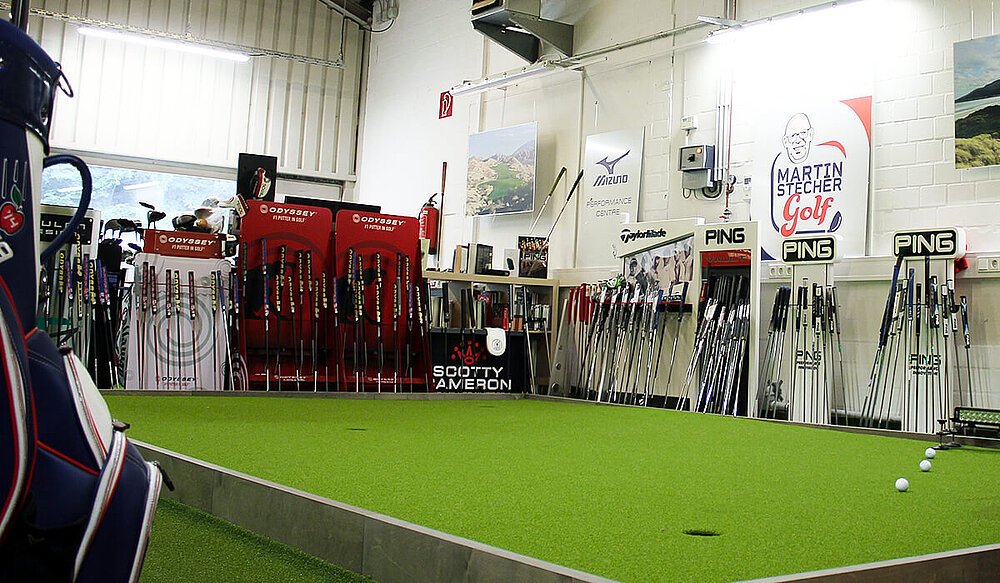
Doing that is not as easy as it sounds. For me, having played the same putter for around 10 years now, I have never really thought about replacing it. I had doubts about the fitting because I couldn’t imagine that my putter might not be the right fit for me. But I tried to keep an open mind as we stepped onto the PuttView green to get the fitting started. “Just hit a couple of putts to that hole location”, says Stecher and activates the Setup, Ideal, and Aiming Lines on the green.
He watches my putts, as one after the other stops short of the hole. It matches what I had already told him about my troubles on the green in general. Thanks to the Ball Tracking it is painfully evident how my putts break away from the Ideal Line. “The lines really help me identify certain things properly. I can tell the swing path in relation to the starting line, Ball tracking makes speed errors visible and alignment issues become clearer. But foremost, it helps the customers understand where different putters improve the shot pattern”, explains Stecher his choice of visuals.
After the first couple of shots, we move on to a putter where virtually every part is movable. It determines the preferred setup and length of the putter. To my surprise, we quickly find out that my putter was about an inch too short for my natural pose.
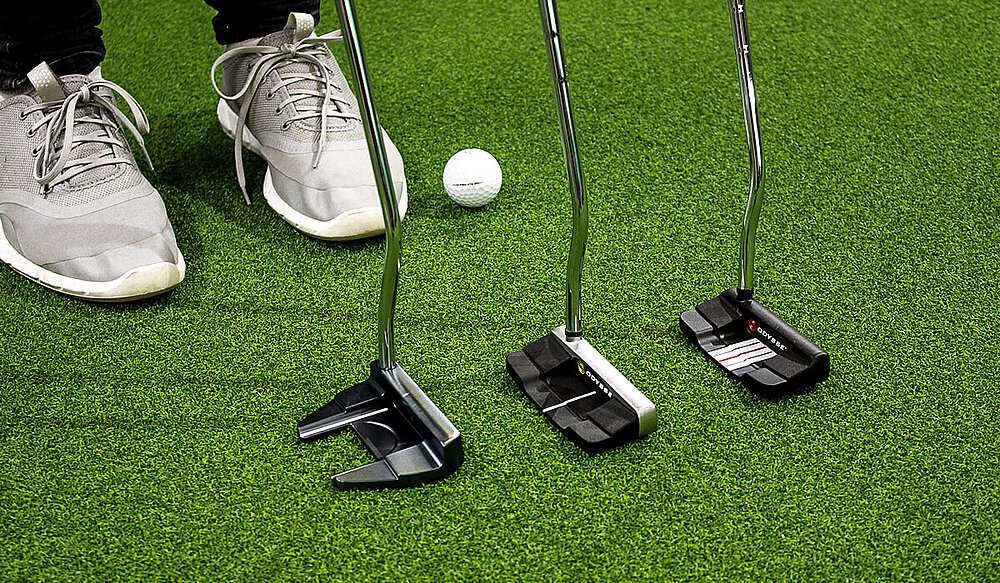
Based on that and the information Martin Stecher has already gathered about my pre-shot routine and my putting stroke, he quickly begins moving around his massive collection of putters. Picking and choosing different types, he returns with a grin on his face. “Again, just keep an open mind”, he says. As I try my way through different types of Mallet and Blade putters and start to get a clearer picture of what helps with my putting, and what doesn’t. Meanwhile, Martin Stecher explains some of the differences to me. “Some people just need some visual support when putting. They are very technical in their approach to putting. For them, Mullet putters or putters with a strong line at the back are very helpful. You tend to be more of a feel player, so you don’t need that kind of support from your putter.” Having narrowed down the possible options of putters to two, Martin Stecher decides to switch things up. “Most fittings are done on even surfaces. The problem with that is, you get used to the putt. But that is not really what happens on the green, right? Even the putt we chose here, a 10 to 15 feet breaking putt, you know the line by now. To get a more realistic picture of what you might encounter on the course, I love the fact that you can pick and choose various breaking putts and starting positions on PuttView.”
By now, Martin Stecher has me convinced. As I have mentioned above, I didn’t think I needed to change my putter, but halfway through the fitting, I suddenly realize that things could be a lot easier for me. Having eliminated a Scottie Cameron alternative earlier in the process, it came down for me to a battle between Mizuno and Cobra. Both putters were up for a head-to-head battle through money-shot putts, as Stecher likes to call the putts inside 5 to 10 feet, and some long-range putts. Eventually, we landed on the Cobra King Vantage Sport-60 Slant Neck Putter with SIK Face Technology putter for the win. “It is so important for the clients to come to that conclusion themselves. I can guide them there, but if they don’t feel and see the results, then there is no convincing them. Obviously seeing the Ideal Line and Aiming Line helps to take away the guessing about possible errors. But mostly, it just makes it easier for the client to understand what is going on and how much the results vary from putter to putter. It creates trust”, explains Stecher.
Last but not least, we putt a couple more putts without any visual support. This time, however, it’s only a comparison between my old putter and the winner of the fitting and the differences become even more visible. A thicker grip, a longer shaft, and a different face insert than with my old putter, do the trick. “In general, you should change your putter every four to five years”, says Stecher. “But you know, if things work just fine, I can definitely understand why people decide to not switch things up.”
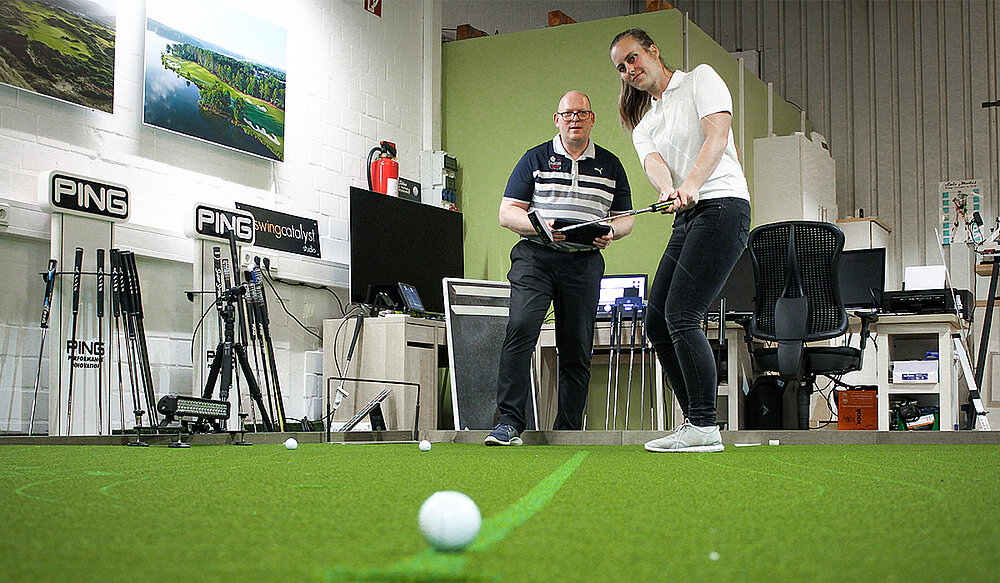
Fast forward the week, as I am standing over my last putt of the day to finish up my round for a +4. As the ball tumbles into the hole, I know that I made the right choice when deciding to give up my old putter. There are things, that you cannot argue against. The logical approach and buildup of Martin Stecher’s fitting, in combination with the trust that was created by seeing the various shot patterns and putts, were undeniable for me. If you think about it, saving two to three putts per round will lower your overall score significantly. Hitting a driver 20 yards longer, or your irons just a little more consistent, etc., won’t have the same immediate effect. So next time, you think about buying new clubs, take into account that maybe now, it is time for a new putter.
Just like the speed of a putt can influence the amount of break you will have to account for, the speed of a green will influence break as well. Intuitively you might think the faster the green the less break you need to play but it is vice versa. The faster a green gets the slower you need to hit your putt, which means that it is more susceptible to break.
In the video below Mike Kanski has simulated with the help of PuttView how break changes when the speed of the green changes. While PuttView is calibrated at a certain green speed, you can change the stimpmeter value manually and PuttView will recalculate the putts accordingly. Obviously you cannot play the putts shown in the video as the green speed has not changed, but you will be able to see how big of an influence green speed has on break. So feel free to try it out if you have a PuttView System or watch the video below.
As we have mentioned above faster greens are not always something you should strive for. A lot of people see perfect green conditions on TV week in and week out but they fail to understand that no golf course in this world is able to maintain this throughout the year. Is it nice to see those pure rolls and quick greens that even the pros struggle with sometimes? Sure, but to be honest most amateurs wouldn’t enjoy those types of greens at all.
No golfer would ever want three or four putts per green as an average and if you are unable to get the ball to stop on the green it definitely won’t add to the pleasure of a round. Additionally, researchers have found that one foot on the stimpmeter will add about 15 min to a round, making it even more undesirable to generally increase green speed and leaving it to the major events such as the club championship.
Instead, the average golfer should start to focus on how they can better manage green speed and changes in it, by finding their reference putt. Because if you are able to adapt your putting stroke, you won’t have to worry so much about whether the green is too fast or too slow for you and can start enjoying your round of golf even more.